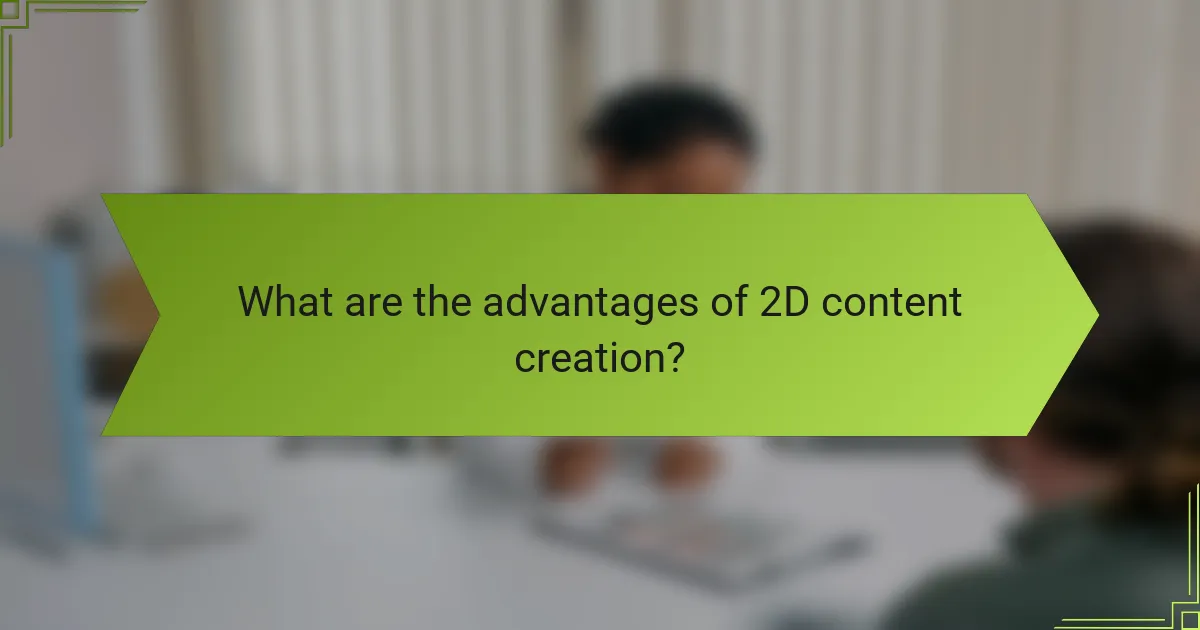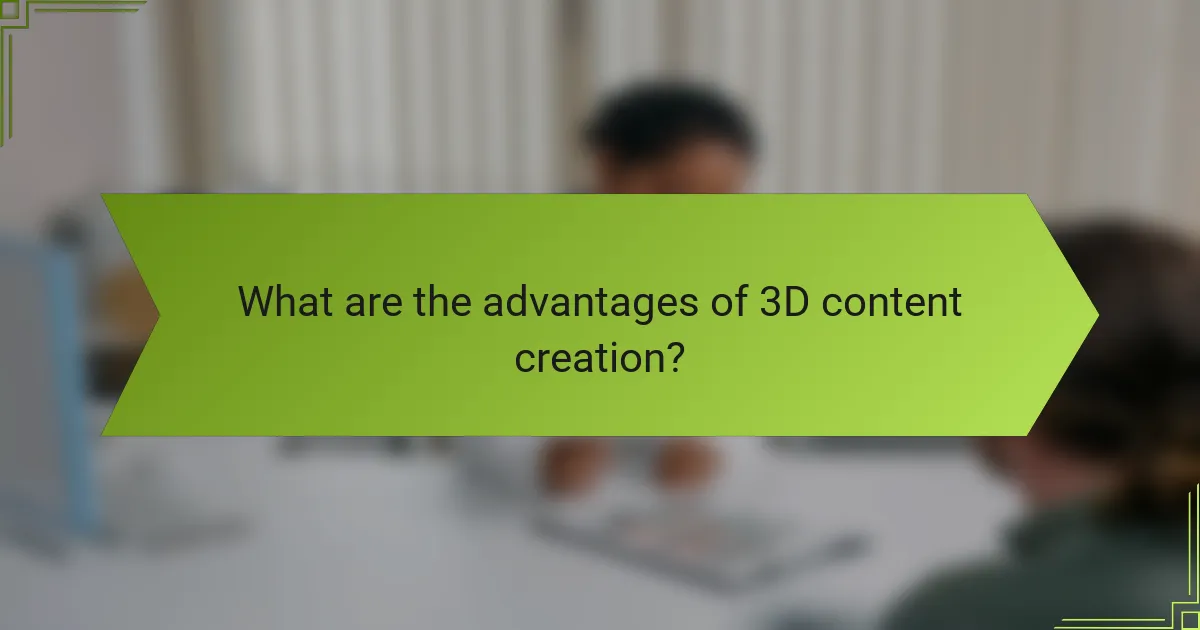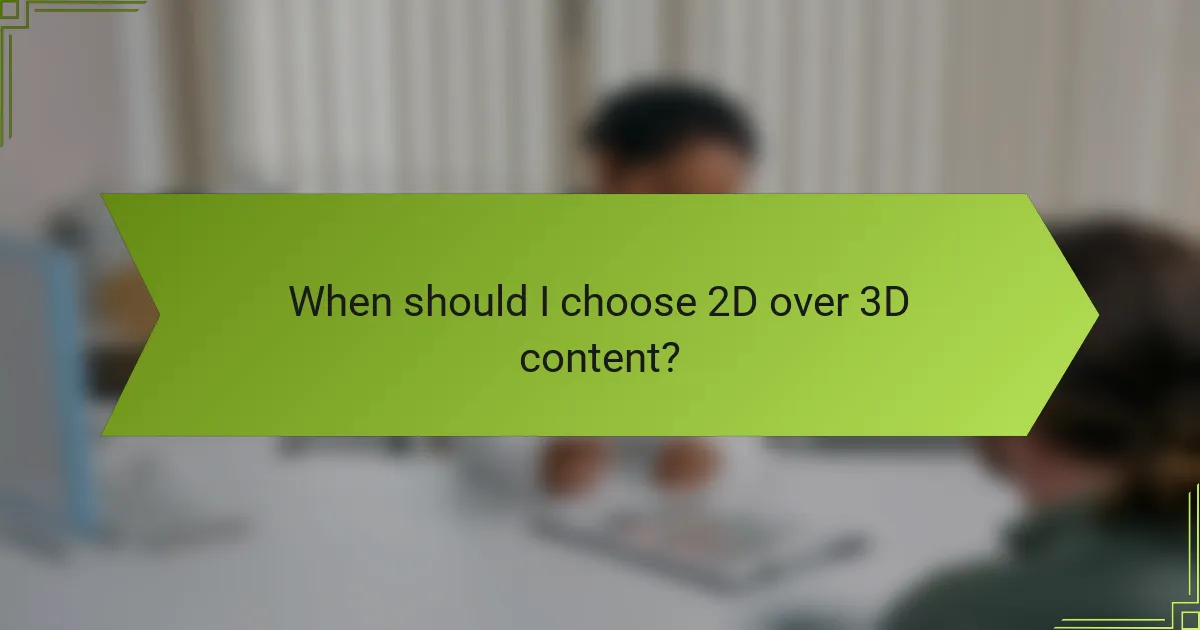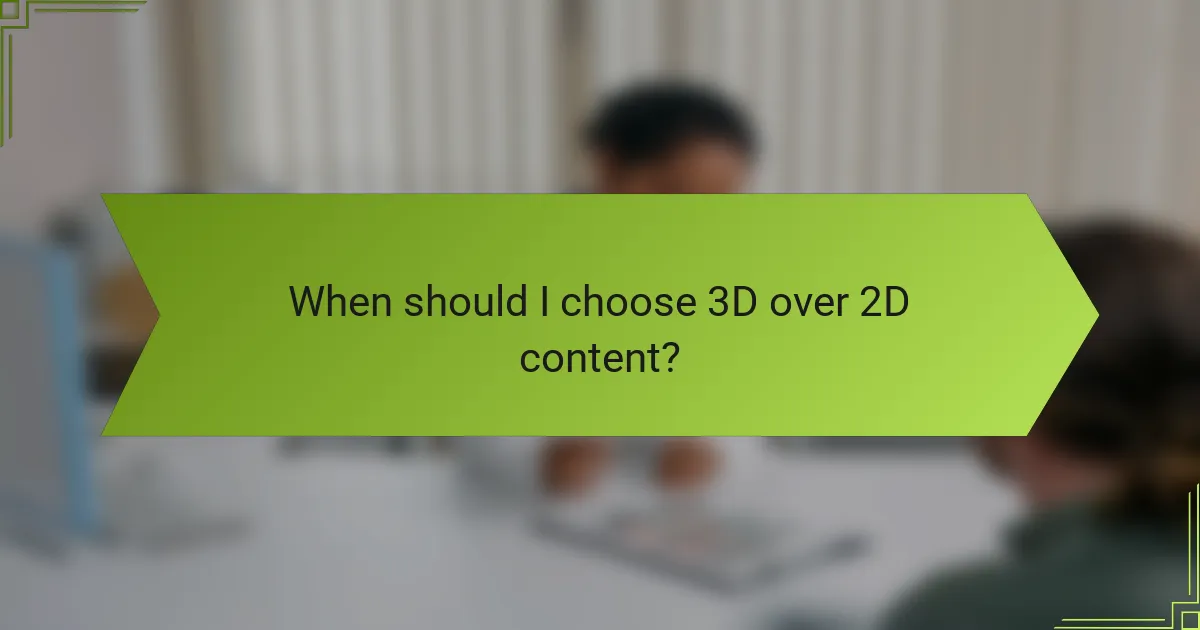When deciding between 2D and 3D content creation, it’s essential to consider the specific needs of your project. 2D content is often more cost-effective and quicker to produce, making it suitable for straightforward storytelling and broader audience engagement. In contrast, 3D content excels in delivering enhanced realism and interactivity, making it ideal for applications like gaming, virtual reality, and architectural visualization.

What are the advantages of 2D content creation?
2D content creation offers several advantages, particularly in terms of cost, speed, and audience reach. It is often simpler and more accessible than 3D, making it a popular choice for various projects.
Cost-effective production
Producing 2D content typically requires fewer resources compared to 3D. The costs associated with software, hardware, and skilled labor are generally lower, making it an attractive option for small businesses and independent creators.
For example, creating a simple animated video in 2D can cost a fraction of what a comparable 3D animation would. This cost-effectiveness allows for more projects to be undertaken within a limited budget.
Faster turnaround times
2D content can be created and edited more quickly than 3D content due to its simpler design processes. Artists can produce 2D graphics and animations in days or weeks, while 3D projects may take significantly longer due to modeling and rendering requirements.
This speed is crucial for industries like advertising, where timely delivery can impact campaign success. Quick iterations and revisions are also easier to manage in 2D, allowing for more agile responses to client feedback.
Wider accessibility for audiences
2D content is generally more accessible to a broader audience, as it is easier to understand and engage with. Many viewers are familiar with 2D styles from cartoons, illustrations, and web graphics, making it relatable and appealing.
Additionally, 2D content can be easily shared across various platforms, from social media to websites, ensuring that it reaches a diverse audience. This accessibility can enhance viewer engagement and retention, making it a strategic choice for content creators.

What are the advantages of 3D content creation?
3D content creation offers several advantages, including enhanced realism, greater interactivity, and advanced visualization capabilities. These benefits make it ideal for various applications, from gaming and virtual reality to architectural design and product visualization.
Enhanced realism and immersion
3D content provides a more lifelike representation of objects and environments, allowing users to experience depth and perspective that 2D cannot offer. This realism is crucial in fields like gaming and virtual reality, where immersion is key to user engagement.
For example, in architectural visualization, 3D models allow clients to walk through a space before it’s built, providing a true sense of scale and design. This can lead to more informed decision-making and fewer changes during the construction phase.
Greater interactivity and engagement
3D content allows for interactive experiences that can significantly boost user engagement. Users can manipulate objects, explore environments, and even participate in simulations, which is not possible with static 2D images.
In educational settings, 3D simulations can help students grasp complex concepts by allowing them to visualize and interact with the material. For instance, medical students can practice surgeries in a virtual environment, enhancing their learning experience.
Advanced visualization capabilities
3D content creation enables advanced visualization techniques, such as rendering and animation, which can convey information more effectively than 2D graphics. This is particularly useful in industries like engineering and medicine, where precise visual representation is essential.
For instance, in product design, 3D models can showcase how a product will look and function, allowing for better marketing and consumer feedback before production begins. This can save companies time and resources by identifying potential issues early in the design process.

When should I choose 2D over 3D content?
Choosing 2D content over 3D is ideal when you need a simpler, more cost-effective solution that effectively communicates your message. 2D graphics are often easier to produce and can be more engaging for certain audiences, especially when the focus is on storytelling or specific platform requirements.
Budget constraints
2D content typically requires less investment compared to 3D, making it a suitable choice for projects with tight budgets. The production costs for 2D assets can be significantly lower, as they often require fewer resources and less time to create.
For example, hiring a graphic designer for 2D illustrations may cost a few hundred to a couple of thousand dollars, while 3D modeling and animation can run into the thousands or more, depending on complexity. If budget is a primary concern, 2D is often the more feasible option.
Simple storytelling needs
When the goal is to convey a straightforward narrative, 2D content can be more effective. It allows for clear visual communication without the added complexity of 3D environments, which can sometimes distract from the message.
For instance, animated explainer videos often utilize 2D graphics to simplify concepts and maintain viewer focus. If your story does not require intricate visual details, opting for 2D can enhance clarity and engagement.
Targeting mobile platforms
2D content is often better suited for mobile platforms due to its lower resource demands and faster loading times. Mobile users typically prefer quick, easily digestible content, which 2D graphics can provide.
Additionally, many mobile applications and games utilize 2D designs to ensure smooth performance across a variety of devices. If your target audience primarily engages with content on smartphones or tablets, 2D may be the optimal choice for user experience.

When should I choose 3D over 2D content?
Choosing 3D content over 2D is ideal when you need to showcase complex products or create immersive experiences. 3D allows for a more realistic representation, making it suitable for applications where depth and interaction are crucial.
Complex product demonstrations
3D content is particularly effective for complex product demonstrations, such as machinery or intricate electronics. It allows potential customers to view products from multiple angles, providing a better understanding of features and functionality. For instance, a 3D model of a car can highlight its interior layout and engine components, which is difficult to convey in 2D.
When creating 3D product demos, ensure that the models are detailed and accurately represent the actual product. Consider using interactive elements that allow users to manipulate the view, enhancing engagement and comprehension.
Virtual reality applications
For virtual reality (VR) applications, 3D content is essential. VR relies on immersive environments that can only be achieved with three-dimensional models and spaces. This technology is widely used in gaming, training simulations, and virtual tours, where users expect a lifelike experience.
When developing VR content, focus on optimizing performance to ensure smooth interactions. High-quality 3D assets are crucial, but they should be balanced with the need for fast rendering times to prevent motion sickness and enhance user experience.
High-end marketing campaigns
3D content can elevate high-end marketing campaigns by creating visually stunning advertisements that capture attention. Brands often use 3D animations and models to showcase products in a dynamic way, making them more appealing to consumers. For example, a luxury watch brand might use 3D visuals to highlight intricate details and craftsmanship.
When implementing 3D in marketing, consider the target audience and the message you want to convey. Ensure that the 3D elements align with the brand’s identity and enhance the overall narrative rather than distract from it.

What are the key differences between 2D and 3D content?
The primary differences between 2D and 3D content lie in their visual representation and the techniques used for creation. 2D content is flat and uses height and width, while 3D content adds depth, creating a more immersive experience.
Visual depth and perspective
Visual depth in 3D content allows for a more realistic representation of objects, as it incorporates height, width, and depth. This perspective can enhance storytelling by providing a sense of space and movement, making it suitable for applications like gaming and virtual reality.
In contrast, 2D content relies on techniques like shading and perspective drawing to create an illusion of depth. While it can be visually appealing, it often lacks the immersive quality of 3D, making it ideal for simpler applications such as illustrations, animations, and web graphics.
Technical requirements
Creating 3D content typically requires more advanced software and hardware capabilities, including powerful graphics cards and specialized programs like Blender or Maya. The rendering process can also be time-consuming, often taking from several minutes to hours depending on the complexity of the scene.
On the other hand, 2D content creation is generally less resource-intensive, allowing for quicker production times. Software like Adobe Photoshop or Illustrator can be used effectively, making it accessible for a wider range of creators, from beginners to professionals.
Audience engagement levels
3D content often leads to higher audience engagement due to its interactive and immersive nature. Users can explore environments and interact with elements, which can significantly enhance their experience and retention of information.
Conversely, 2D content can still engage audiences effectively, especially in contexts like storytelling or branding. However, it may not capture attention as strongly as 3D, particularly in competitive fields like gaming or advertising where visual impact is crucial.

What tools are commonly used for 2D content creation?
Common tools for 2D content creation include software that allows artists and designers to create graphics, illustrations, and layouts. Popular options vary in complexity and features, catering to different skill levels and project requirements.
Adobe Photoshop
Adobe Photoshop is a leading software for raster graphics editing, widely used for photo editing, digital painting, and graphic design. It offers a robust set of tools for manipulating images, including layers, filters, and brushes, making it suitable for both beginners and professionals.
When using Photoshop, consider its subscription model, which can be a recurring cost. It’s ideal for projects requiring detailed image work, but may not be the best choice for vector graphics, where other tools excel.
CorelDRAW
CorelDRAW is a vector graphic design software that excels in creating logos, illustrations, and layouts. It provides a user-friendly interface and powerful tools for precision drawing and typography, making it a favorite among graphic designers.
CorelDRAW is particularly effective for projects that require scalability, as vector graphics can be resized without losing quality. It’s available as a one-time purchase or subscription, giving users flexibility in how they choose to pay.
Canva
Canva is an online design platform that simplifies the creation of graphics, presentations, and social media content. Its drag-and-drop interface and extensive library of templates and assets make it accessible for users with little to no design experience.
While Canva is great for quick and easy designs, it may lack some advanced features found in Photoshop or CorelDRAW. It’s best suited for small businesses or individuals looking to create professional-looking content without a steep learning curve.
